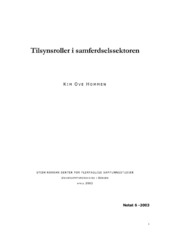| dc.contributor.author | Hommen, Kim Ove | eng |
| dc.date.accessioned | 2006-06-21T15:21:52Z | |
| dc.date.accessioned | 2020-12-10T06:33:50Z | |
| dc.date.available | 2006-06-21T15:21:52Z | |
| dc.date.available | 2020-12-10T06:33:50Z | |
| dc.date.issued | 2003-04 | eng |
| dc.identifier.issn | 1503-0946 | |
| dc.identifier.uri | https://hdl.handle.net/1956/1401 | |
| dc.description.abstract | This article focus on how two supervising authorities on the transport sector, The Civil Aviation Authority (CAA) and the Railway Audit Authority (RAA), have obtained different audit roles. This despite being supervised by the same ministry and having a similar mandate. Both agencies are young in their present form. I study how interaction with the organizational environment and developing internal culture makes a difference in organizational identity and audit performance. To describe audit-roles I use the indicators role consciousness, audit performance, task priority and reporting system. As theoretical tools to analyze the findings an instrumental, an institutional and an environmental perspective is used. Main findings are also compared and categorized through recognized categories for audit-roles and control mechanisms. Within role indicators the variations between the organizations studied exceeds that which can be explained by looking at the two bodies mainly as tools used against a given goal. Both internal characteristics and the task environment affect the organizational identity and audit-role. The CAA performs more physical control than the RAA. The rules and regulations in the civil aviation sector are stricter, more numerous and more specific. In the railway sector the RAA has more a supervisory role and audit personnel have more leeway when interpreting regulations. While the CAA can be categorized as a magistrate, in the RAA I recognized more the role of a “misunderstood” consultant. In the railway sector there is a history of major communication problems between the RAA and the railway co-operatives. In many cases the co-operatives have actively ignored the RAA and their recommendations regarding security inspections. When 19 people were killed in the Åsta accident, it forced the co-operatives to adopt a more humble attitude. The following investigation blamed the co-operatives for lack of security systems. The RAA gained a much stronger position as a supervising authority on the sector after this accident. In the civil aviation sector the CAA maintains respect and a good relationship with its audit objectives. This can be traced back to common competence and corporative participation in rule making. In general I find that the responsibility structure on the civil aviation sector is clearer and less confusing than the corresponding structure in the railway sector. However the CAA has had longstanding internal problems between audit departments, between new and old personnel and between leadership and employees. The findings show most similarities between the audits connected to task priority and reporting. This can be traced back to the common reporting institution, which is the Ministry of transport and communications. An interesting finding is that for both agencies the reporting of goal achievements to the ministry is unlikely to have any significant consequence attached to it. The last part of this paper comment on the Norwegian audit debate. | en_US |
| dc.description.abstract | Dette notatet viser hvordan to fristilte tilsynsorganer, Luftfartstilsynet og Statens Jernbanetilsyn, underlagt samme departement og med relativt likt mandat, har tilegnet seg ulike tilsynsroller i interaksjon med sine omgivelser og gjennom utvikling av interne normer. I studien brukes rolleoppfatning, tilsynspraksis, og oppgaveprioritering og rapportering som indikatorer på tilsynrolle. Empiriske funn kategoriseres i forhold til ulike idealtyper av kontrolletater og kontrollmekanismer. Som analyseverktøy brukes et instrumentelt rasjonelt perspektiv, et lukket institusjonelt perspektiv og et omgivelsesperspektiv. Undersøkelsen er lagt opp som et case-studie med intervjuer og dokumentanalyse som metodiske hovedtilnærminger. Studien viser en klarere formell og reell ansvarsdeling mellom tilsynsmyndighet og pliktsubjektene på luftfartssektoren enn på jernbanesektoren. Luftfartstilsynet bærer preg av å være en kontrolletat med mindre bruk av skjønn i regelanvendelsen og mer vekt på fysisk tilsyn. Likevel opplever Luftfartstilsynet et kompetansefelleskap og til en viss grad et kollegialt forhold til markedsaktørene. Statens Jernbanetilsyn har flere av informasjonsetatens kjennetegn og bruker mer skjønn i kontrollvirksomheten. Samarbeidsklimaet mellom tilsyn og pliktsubjekter i jernbanesektoren har over tid vært anstreng. Statens Jernbanetilsyn har hatt store problemer med å formidle den sikkerhetsfilosofien de representerer. Åsta-ulykken står som en milepæl på jernbanesektoren og har gitt Statens Jernbanetilsyn en helt annen posisjon gjennom økt autoritet og respekt hos jernbaneaktørene. Luftfartstilsynet har på sin side tidvis vært preget av ulike interne konflikter. Luftfartstilsynet legger størst vekt på å rekruttere flyfaglig og teknisk kompetanse til sine revisjonsteam. Statens Jernbanetilsyn legger på sin side stor vekt på generell revisjonsfaglig kompetanse. Dette har sammenheng med Statens Jernbanetilsyns størrelse, men er også som følge av kompetanseprofil og et noe annerledes og mer overordnet sikkerhetsfokus. Størst likheter mellom tilsynsorganene finnes i forhold til oppgaveprioritering og rapportering. Den formelle rapporteringen i forhold til måloppnåelse ovenfor departementet oppleves imidlertid i liten grad å danne grunnlag for overordnede styringssignaler eller ha andre konsekvenser knyttet til seg. Notatet drøfter til slutt forvaltningspolitiske implikasjoner av studiens hovedfunn sett i lys av dagens aktuelle debatt omkring tilsynsorganisering. | no |
| dc.format.extent | 487523 bytes | eng |
| dc.format.mimetype | application/pdf | eng |
| dc.language.iso | nob | eng |
| dc.publisher | Stein Rokkan Centre for Social Studies | eng |
| dc.relation.ispartofseries | 6-2003 | |
| dc.relation.ispartofseries | Notat | no |
| dc.title | Tilsynsroller i samferdselssektoren | nob |
| dc.type | Working paper | eng |
| dc.subject.nsi | VDP::Samfunnsvitenskap: 200 | nob |
